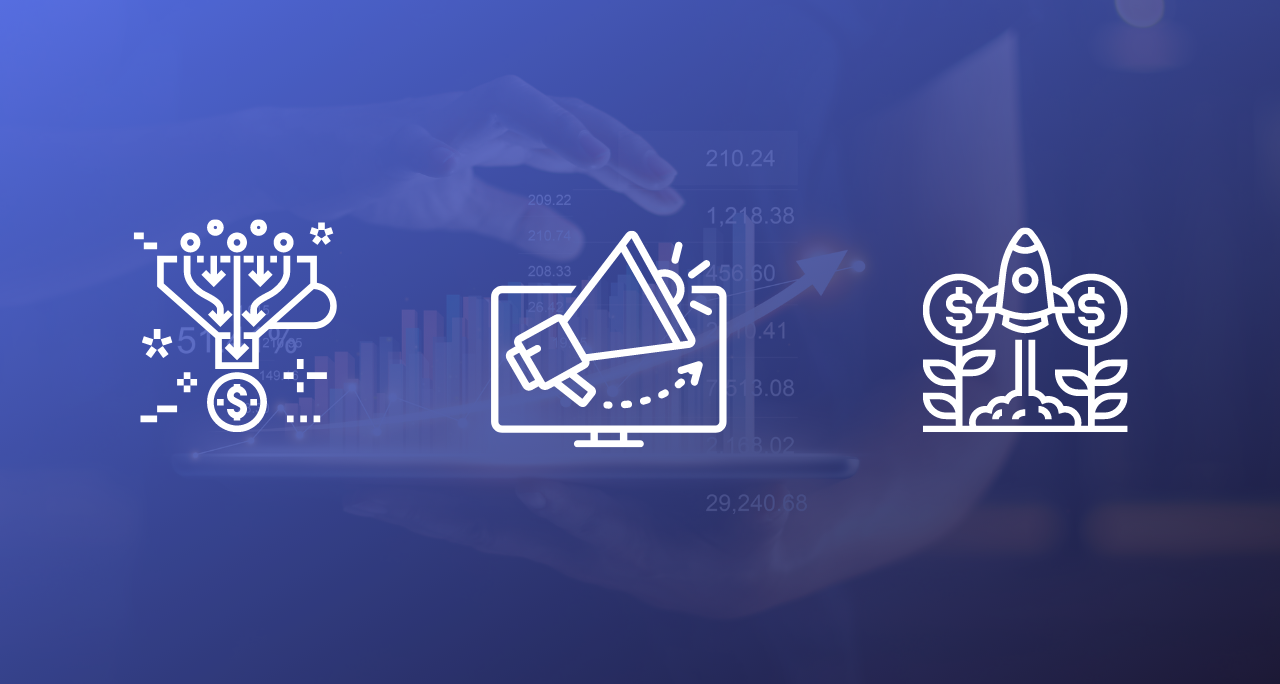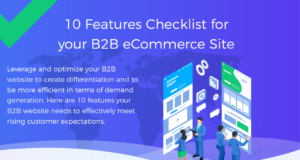An essential piece of sales success is attracting the qualified lead: the customer who has the need and financial capacity to buy your product or service. Drawing in and ultimately converting this kind of high-value prospect requires using the right combination of lead generation channels. But, in the B2B space, the lead generation and sales process can be far from quick and straightforward. Not all lead gen channels are the perfect fit for every business. B2B marketing differs from one type of industry to another, and each channel may work well for one but not for the other.
Any savvy marketer will need to take a good look at what works best for them to attract these high-value, “qualified” leads (who hopefully become loyal customers).
Understanding the B2B Sales Funnel
B2C buyers are known for making purchases impulsively, based on emotion. By contrast, B2B buyers have ROI in mind, and use a more logical approach when making purchases; often the decision is made as a group rather than by a single person (as in B2C). Even so, there are many areas in which B2B and B2C customer buying behaviors converge and a good example is that B2C buyers have become even more sophisticated when it comes to their purchasing decisions. Both groups require transparency, tailored offers and communications and as much product detail as possible.
Because the stakes (and investment) are higher in B2B, entreprise buyers, therefore, tend to be better informed, which means that they may join and then depart the funnel numerous times during a sales cycle.
Let’s take a look at the B2B sales funnel. It consists primarily of three stages, with a customer retention stage to follow:
- Stage 1: TOFU. At this Top of the Funnel stage, you are attracting new prospects and providing valuable information about how your product or service can solve those prospects’ problems.
- Stage 2: MOFU. This Middle of the Funnel stage is where you are creating a strong connection with your prospective customers, sharing content that helps illustrate how you can help them combat their pain points.
- Stage 3: BOFU. During the Bottom of the Funnel Stage, you are answering any final questions the prospect may have and clearing the way to an imminent purchase.
After these three stages, the remaining step is customer retention, which, if successful, will result in additional, repeat business and referrals by your customers to others. Along the way, it’s advisable to use segmentation based on data to see where in the sales journey your prospects are, in order to target them appropriately.
The B2B funnel may look something similar to this:
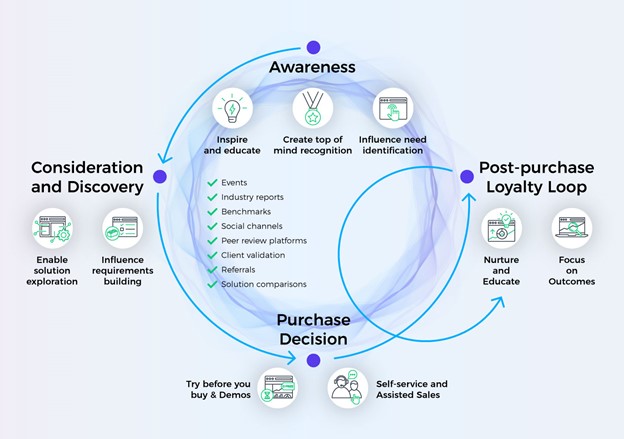
It’s important to provide a personalized and consistent experience across all touchpoints, at every step of the buyer’s journey.
All of that is possible with account-based marketing. This is highly used in B2B marketing and it involves having marketing and sales team work together to target specific sets of target accounts. ABM requires you personalize all assets for each account, so you become fully relevant to them. Nurturing targeted members with the right marketing messages speeds up the sales cycle, which helps sales teams achieve higher close rates and close deals faster.
Next, we will share our insights into some of the top channels for successful B2B lead generation, including email, content marketing, social media (LinkedIn, in particular), SEO/Organic search, pay-per-click and more. We will also describe the growing prominence and importance of omnichannel marketing, and how to form an effective strategy if your business chooses this route.
B2B Marketing Channels to Use in 2021
1. Your Website
This is your most important digital marketing channel, so it has to be built flawlessly. Present in a clear manner what your products and services are, as well as which industries your target customers should belong to. Your website should be easy to navigate, load fast and be responsive on all devices. Include elements that will build trust and have a Resources area with helpful content.
Make your Call-to-Action easy to access and don’t forget to add forms for your content pieces. You can even use website visitor identification software which allows you to see which companies visit your site and supplies other key information.
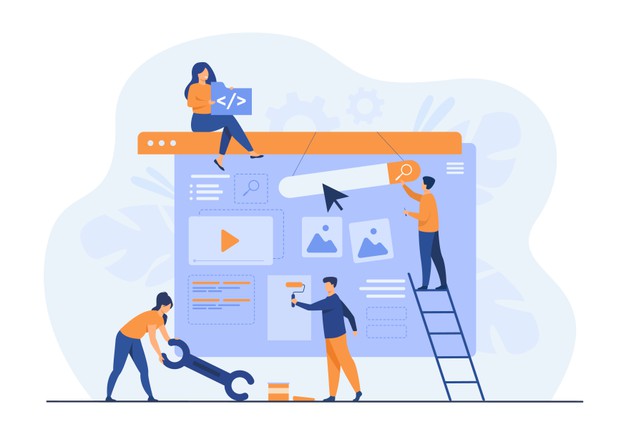
Essentially, website visitor identification software does the following:
- Collects company contact information
- Filters visitors based on their profiles
- Shows you how often they visit and how long they spend on your site
Armed with this additional information, you can add automated alerts so your sales team can conduct timely follow-up, and integrate the info with Google Analytics and sales and marketing tools like your chosen CRM or MAPs. This software will provide your sales team with the valuable information they need to convert visitors into qualified leads.
Funnel stage: All stages
2. Marketing automation
Email might seem old school, but it’s still among the most popular marketing tactics used in B2B today, with the starting point of most sales begins with the customer opting in by supplying their email. Email marketing is still among the best tools to engage with customers, share information, and pitch new products or upgrades. But taking it one step further, leveraging marketing automation strategies brings great opportunities for increased conversions.
Marketing automation allows you to nurture customers according to their needs by speaking with them and not to them. When you log in to a service or interact with a product, it can trigger relevant messages that bring you along the customer journey, closer to making an initial purchase, expanding your usage or even upgrading.
What’s important to remember is that while creativity and clever prose are certainly key to successful emails, there is also a more rigorous science to this channel. Here are some of the tactics that will drive email marketing conversion rates:
- Provide the irresistible hook. It’s essential to have an enticing offer right off the bat: content, freebies, or a deal that can’t be refused.
- Perfect your landing page: Make the offer and benefits of connecting clear and appealing.
- Craft your subject line: Make it to the point but compelling, with a clear description of benefits.
- Segment in order to target: Break down your list of recipients into smaller lists so that you can target more directly, which will increase open rates and CTRs.
- Follow up with analytics: This is where you can narrow down who your qualified leads are, see what worked and what didn’t, and clean up your lists as appropriate.
There are plenty of ways to use marketing automation to your advantage! If you’re already doing email marketing stepping it up to marketing automation should be your next consideration.
Funnel stage: MOFU, TOFU, Retention
3. Content marketing
Content marketing in B2B involves employing strategies that will result in brand awareness, audience engagement, lead generation, and higher sales. Unlike B2C brands, who use content marketing primarily to build brand awareness and create an emotional connection, B2B brands use content marketing to provide their audience with expertise, via different formats, to engage their customers, build trust, and convince them they can solve their problems.
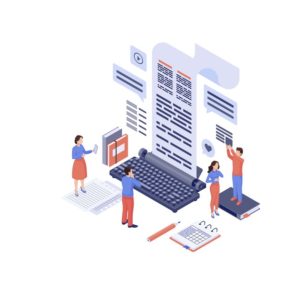
Great content will help you reach customers at the top of the funnel and will also help you continue to engage and nurture those deeper in the sales funnel. It’s important to have a diverse mix of content and content vehicles to maximize the overall benefits; these should include but are not limited to:
- Blog posts. The go-to for content marketers, with unparalleled SEO benefits, blog posts are ideal for the TOFU audience.
- Webinars. Great way to educate your audience on a certain topic and offer them the chance to address live questions
- Infographics. These are charts, graphs, or other visual elements that summarize information to show trends, give an overview, etc.
- Videos. More and more, B2B marketers are using video to share brand, product information, and educational content via webinars, live video, etc.
- EBooks. These long-form guides can be offered as a freebie for a prospect, when they supply their contact info; they then become a lead for your business.
Funnel stage: All stages
4. Social media
Since over 42% of the world’s population uses social media, it’s important that B2B companies plan their social strategy to survive in the competitive market. By sharing content on social media outlets, brands can generate leads while boosting their authority and gaining valuable opportunities to interact directly with their potential customers.
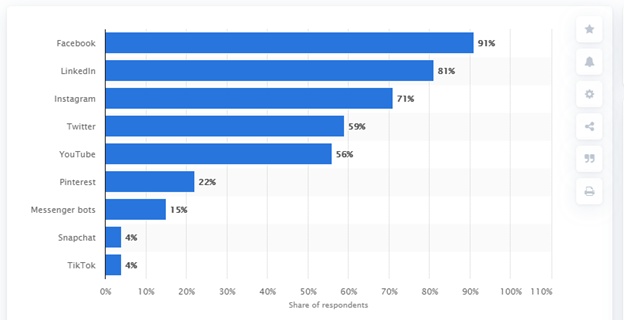
According to a recent report by Statista, Facebook, LinkedIn and Instagram are among the leading social media platforms used by B2B marketers worldwide. Paid social media ads are a reasonable outbound alternative to doing the heavy lifting of building an organic following. That all said, generating qualified leads via social media is far from easy and there is no real science for success. LinkedIn, is among the best social media platforms for generating B2B leads. As a large community of professionals, many of whom have decision-making powers and the income to match, LinkedIn can be an excellent venue for lead generation; it’s important to remember, however, that it won’t happen by itself.
Here are some ways to maximize lead generation via LinkedIn:
- Complete your business’ profile. Make sure your company’s presence on LinkedIn is robust, with a comprehensive profile and easy ways to connect with company contacts as well as a link to your business website.
- Stay active. Post news about your company, join conversations, and connect with your colleagues and other industry professionals.
- Join LinkedIn groups. Groups on LinkedIn provide professionals in the same industry or with similar interests a great space to share content, find answers, post and view jobs, establish themselves as industry experts, and make business contacts and generate leads.
- Participate in LinkedIn conversations. Join and participate in ongoing discussions and threads to make your presence more visible (and, ultimately, to generate leads).
Funnel stage: TOFU, MOFU
5. Events
Networking, with its opportunities for one-on-one, personal interactions with your prospects, is still a tried-and-true marketing channel for B2B. In-person events and conferences can be tremendously effective at building relationships in ways that an email or phone call can’t match. Remember, your B2B prospects are mostly likely there to do business, not just look around.
To make the most out of your networking efforts, it’s important to do some advance homework. The following steps will help you maximize the time spent:
- Know who’s on the guest list
Doing some advance research can help make the time (and money) spent on events and conferences worthwhile. Target the right events, and then find out what businesses and individuals will be there, and which of them could be the most valuable as prospects for your business. Connect with as many attendees as you can on LinkedIn before the event/conference date, and message those of value to propose a meet-up at the event. And, naturally, mixing and mingling at the event itself is a prime opportunity to build new business relationships.
- Listen first, sell later
Events are for making connections, answering questions, understanding how your product or service might connect with the pain points of those you meet, and building trust. Let the sales pitch come later, now that you’ve connected with these prospects, during follow-up meetings. Events are relationship-building opportunities, not the time to “seal the deal.”
- Rely on social media and, yes, old-school business cards for networking
Events and conferences are busy and chaotic, so it’s important to provide prospects with your information. Give them your business card and let them know you’ll follow up with them on LinkedIn or other social media (and then don’t forget to follow up).
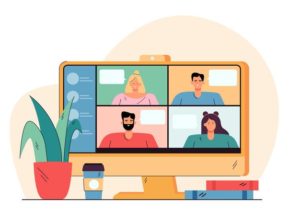
Use virtual events to your advantage
2020 has seen almost all in-person events turn virtual, and although it can feel intimidating, many aspects of the digital format can actually work in your favor over traditional live events. Some of the advantages:
- Flexibility: Virtual events can be attended from anyone with an internet connection, from anywhere and even from any time zone, meaning you can reach an even wider audience from varied markets.
- Cost savings: Holding an event virtually cuts out costly line items like renting a venue, staffing and catering the event, and travel costs.
- A wealth of data: Using event platform software that integrates with your CRM platform or marketing software can be like a crystal ball, providing in-depth, granular attendee information and demographics that can guide your follow-up efforts after the event.
Funnel stage: All stages
6. Search engine optimization/organic search
SEO is still number one among the best B2B marketing channels for identifying and attracting qualified leads and ranking well in search results is essential. This can take the form of blog posts, landing pages, and other types of long-form content that are able to perform well in organic search.
It’s not always easy, however, and involves more than just search keywords. Some of the pieces to focus on include the following:
- Identify keywords that align with every stage of your customers’ buying cycle.
- Organize the results along your sales funnel. Keywords that generate a strong informational intent are most likely going to represent top-of-the-funnel users; those with a strong purchase intent are likely being used by bottom-of-the-funnel prospects.
- Review and optimize your existing content. If certain content has been created to target a specific keyword, make sure it is addressing the user intent behind that keyword.
- Identify where your content is lacking and supplement it. If one of your top keywords reveals a strong inform intent in the search results and website is missing substance on that term, build your assets around that keyword.
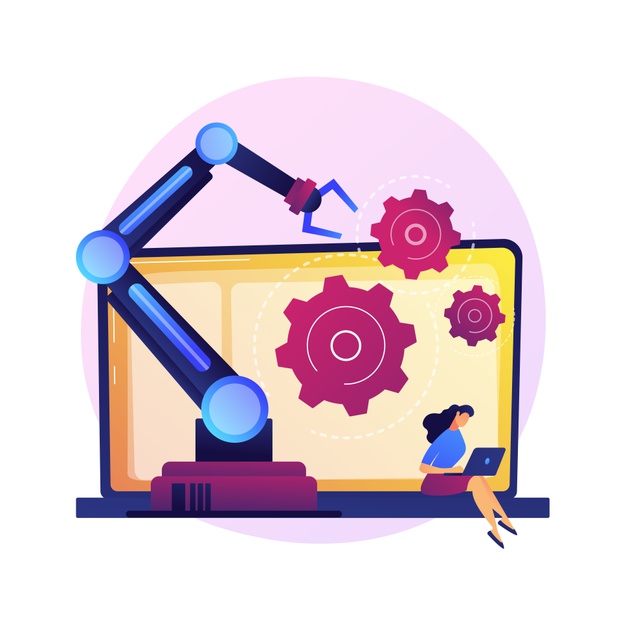
Don’t forget about the technical SEO factors like loading speed, sitemap, navigability etc. You should optimize your website regularly to maintain its relevancy within the ever-changing algorithms, and an SEO website audit is a good starting point in this process. Here’s how to perform one.
Funnel stage: TOFU, MOFU
7. Influencers & Brand Partnerships
According to Invesp, the ROI from influencer marketing can be eleven times greater than with more traditional forms of digital marketing, so this is a channel worth pursuing. Choose your influencers carefully, based on their engagement rates, the quality of their content and social following, and their ranking in organic search results. Then, use any of these commonly use B2B marketing strategies:
- Share your company’s authoritative content—and solicit the same from influencers.
Ask to share a guest blogpost on a high-domain authority’s website and ask your influencers to contribute with a guest article to your company’s own blog.
- Look for opportunities for content collaboration.
An example could be putting together a curated collection of influencer tips or insider ideas to be featured on your website, like “X Experts Share Their Favorite eCommerce Trends.”
- Ask them to be a guest speaker at one of your events.
This will not only help promote your event and boost participation, it adds significant value to your participants, reflecting well on your company and building their trust.
- Offer free trials or discount codes.
Provide your influencers their own unique code to share with their followers—this is an easy way to help generate new leads.
- Use your own customers as influencers
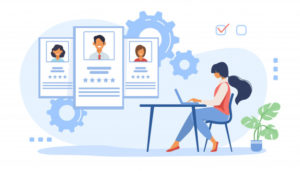
There is nothing more valuable or potentially influencial to a prospect than positive reviews from existing clients. Use your clients’ experiences as customer success stories to share with prospective clients.
Funnel stage: All stages
8. Pay per click (PPC)
Although it can get expensive, PPC is a popular form of online advertising that can result in significant lead generation for B2B, giving your SEO posts more visibility than an organic search result. When you pay for each visitor to your site, you can be reasonably sure that all of those visitors are interested in becoming leads by selecting keywords with clear purchase intent, like “buy [your product].”
PPC can be used across channels, including Google, LinkedIn, Facebook and others, although B2B marketers rely most heavily on Google Ads because it’s the largest and most popular PPC network. As it is expensive, however, it’s important do the following:
- Find high-value keywords. Find out which keywords your competitors target and what is the competition score for them.
- Structure your campaign and draft your ad copy. Because of the multiple stakeholders and various stages of purchase, add appropriate calls-to-action and offers to your copy and make sure it speaks to the buyer’s pain points.
- Create specific landing pages. Your PPC ads should send users to a landing page on your website that provides exactly what the ad promises. They should be able to get the information they are seeking or take action without clicking to another page.
- Track your metrics. It’s important to balance your ads’ rankings, your ad spend, and your ROI.
- Monitor your campaigns. There are many things to watch, but you should primarily aim to improve your click-through rate (CTR) and your quality score (QS), and lower your cost per click (CPC).
Funnel stage: TOFU, MOFU
9. Referral programs
Referral marketing is definitely not just for B2C. B2B decision makers also tend to turn to the people they know and trust when deciding upon a next important purchase. According to Influitive, 84% of B2B decision makers start the buying process with a referral. And yet, only 30% of enterprise companies have a referral program in place.
Prior to the purchase, a B2B company goes through a complex sales journey, a long decision-making process, and a number of stakeholders. It’s rare that a B2B will agree to an instant transaction, as they also require a highly personalized experience.
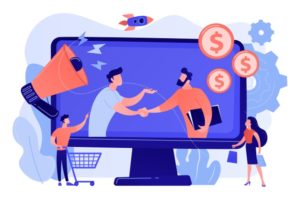
When creating a referral programv, make sure it’s more than a submission form buried somewhere on your website. An option would be to consistently engage your top customers through an advocate marketing program. Nurture your relationship with them and give them incentives and rewards for supporting your brand. Make your messaging clear, compelling and your CTA short – remember your B2B clients are busy and they want to see what’s in it for them.
Think of it as a private community for your best customers. Once your advocates connected to your company and valued, they will be ready to submit high-quality referrals. Promote your referral program on your website, blog, social media channels, newsletters but also reach out to your clients directly. Just make sure to choose the timing carefully, as you want to get in touch with them when they’re happy and satisfied with you.
Funnel stage: TOFU, Retention
10. Remarketing
Remarketing can be a valuable tool that maximizes the ROI of your paid advertising spend to generate new B2B leads, ease them along in the sales process, improve your email marketing, nurture them along the sales process, increase your email marketing accomplishments, and encourage your existing clients to come back for repeat business.
Here are just a few strategies to try out:
- Create remarketing lists for each stage in your sales funnel, and then target users within each stage with campaigns designed to convert them into leads, depending where they are in the sales process.
- Create several different landing pages for your remarketing, with different messages depending on what customers may need to convert. You can use landing page software like Unbounce and Instapage, which make it easy to create and test a multitude of landing page messages.
- Use remarketing lists to move B2B leads along your sales funnels, guiding them through every stage of your sales funnel until they convert to being paying customers.
Customers who visited your website and viewed a product page can be added to your remarketing list; if they abandon their cart they can be added to another list for which you send ads encouraging them to close the deal.
- Use port-purchase remarketing
Now that you have already invested time and money into getting customers on board, don’t stop there. Target them again to keep them engaged and buy again when the time comes.
Funnel stage: MOFU, TOFU, Retention
Omnichannel Marketing Is on the Rise
In terms of lead generation, omnichannel is important. Today’s customers expect touchpoints to integrate, whether they are social media ads, a newsletter sent via email, a mobile push notification, or an online chat with your bot.
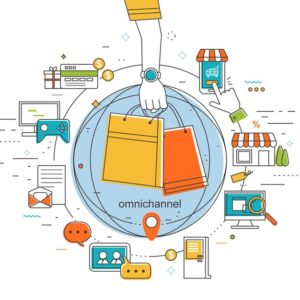
How to create an effective omnichannel strategy? It can take a lot of time and resources, but it will be worth it in the end. Here are some of the essential steps:
- Know your customer. Learn about their needs and wants, ask them questions and solicit feedback, and leverage social media for information about what makes them tick.
- Choose the right channels, the ones that suit your customers the best.
- Assign each channel a purpose. One could be for interaction, another for news, etc.
- Make sure all your channels are connected. This may be difficult to finesse, but as much as possible track your touchpoints to ensure the experience is seamless and consistent.
- Maintain your channels: Keep testing your strategy for what works and what doesn’t, and evolve as needed, to keep your customers happy and returning.
To conclude
B2B lead generation is essentially customer acquisition, with the goal of getting customers with high value into your sales funnel. Now more than ever, it’s essential that B2B marketers make it easy for these qualified customers to find their product or service through a broad offering of channels.
Ultimately, finding the right balance is about understanding the dynamics, costs, and potential results of each lead generation channel, and finding the right combination that supports your unique goals and helps the best (yes, qualified) customers find you at the right time. Knowing your audience and how they interact with your business is the best guarantee that you will find success.
If you want to discover more B2B eCommerce opportunities, read our Top 10 Features Checklist for Your B2B eCommerce Site.

